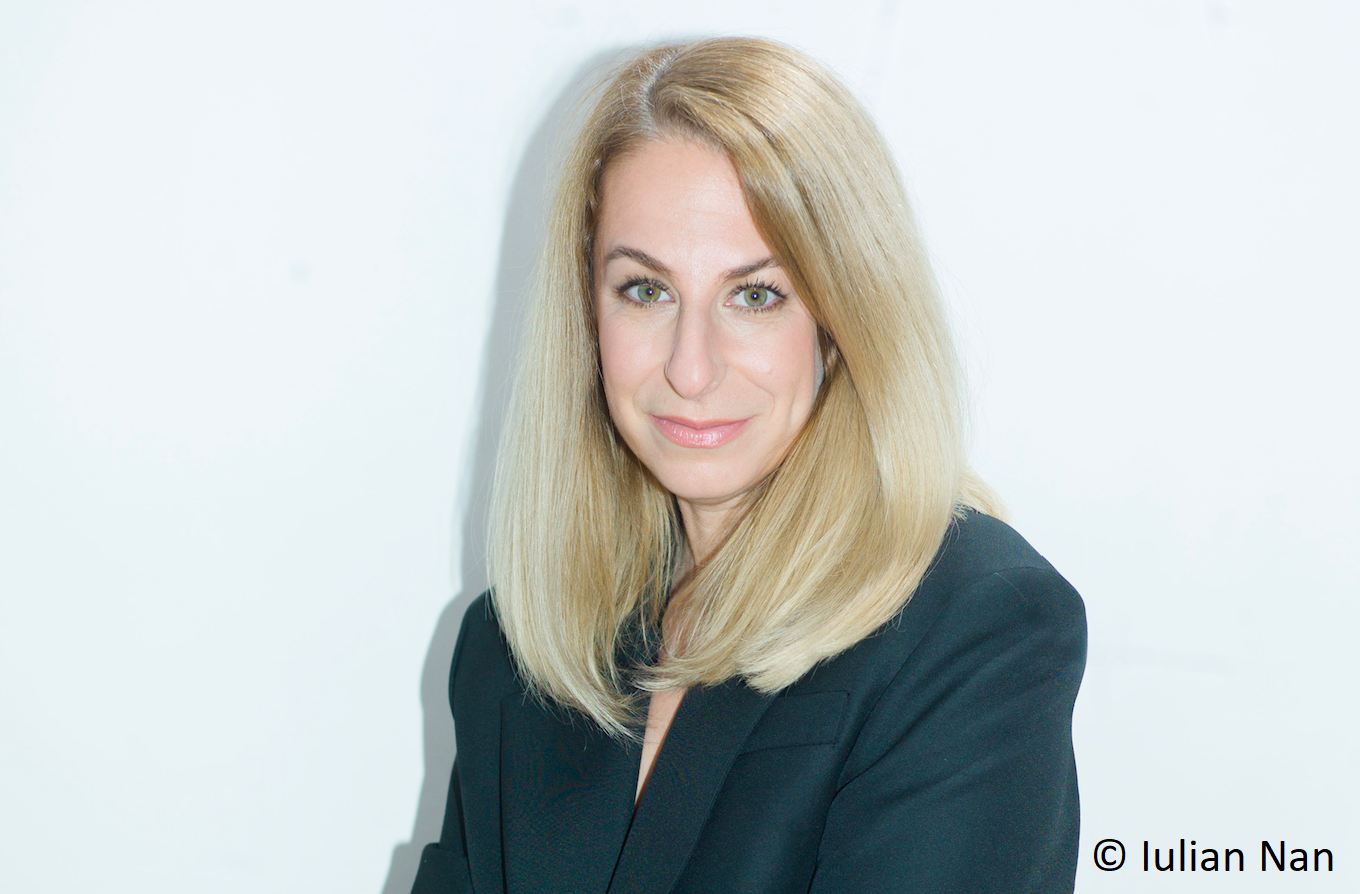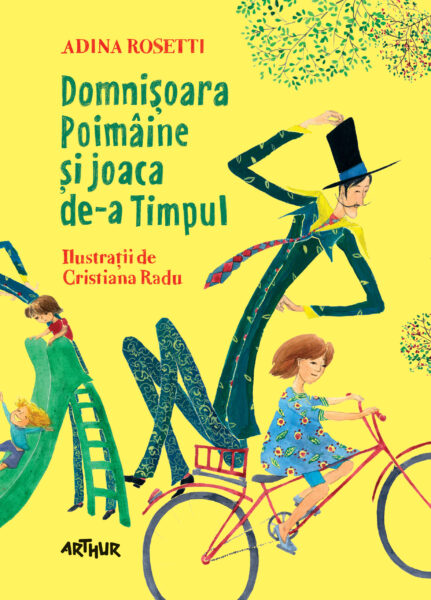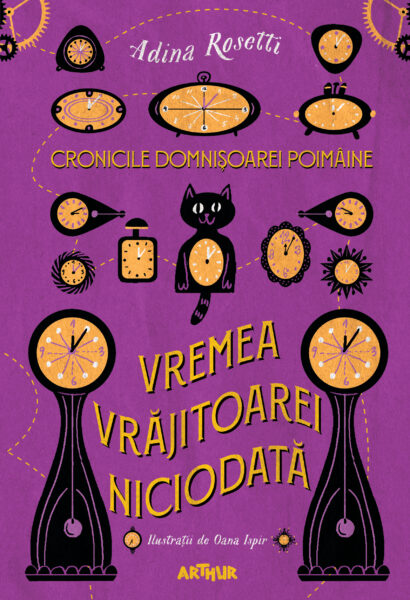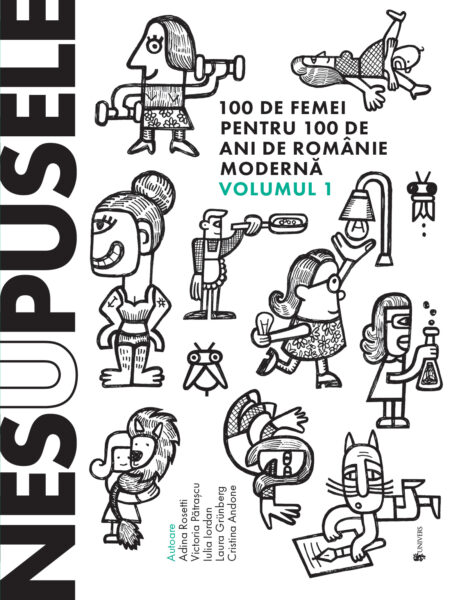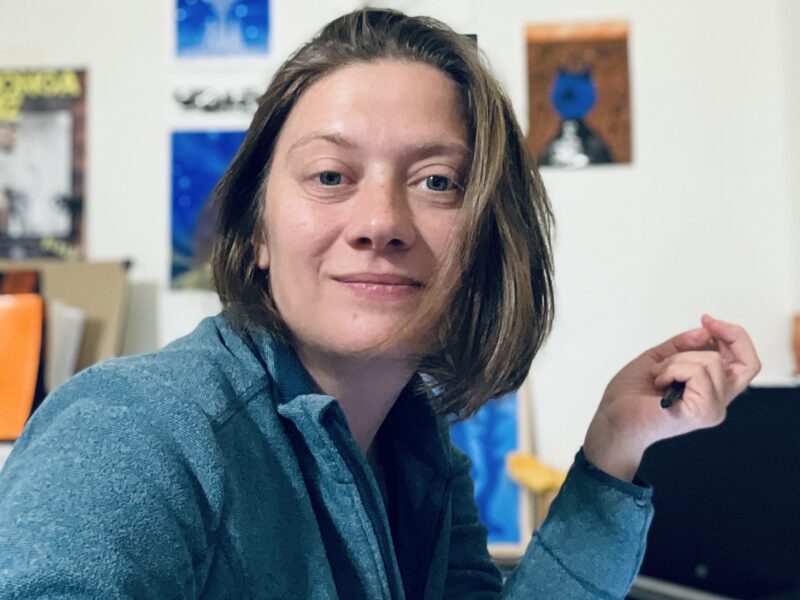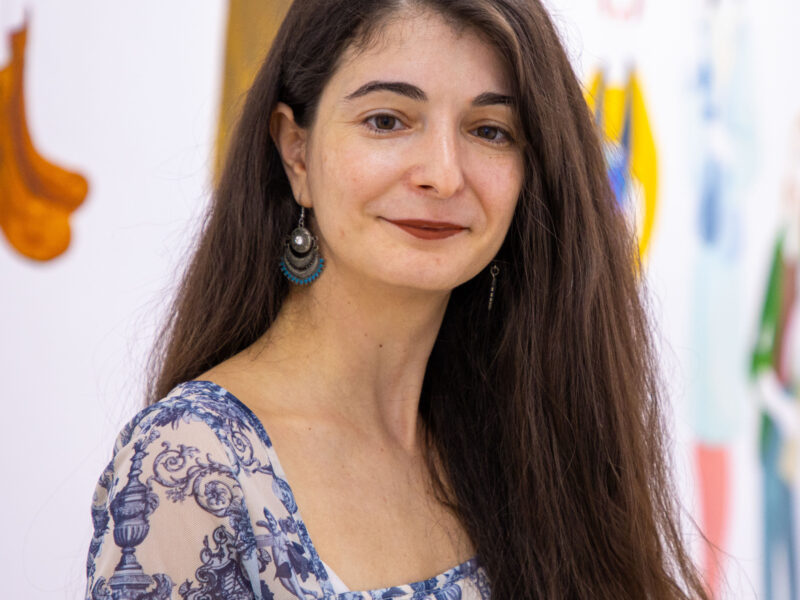Adina Rosetti Adina Rosetti is a writer and the agent and lyricist of the fantastic The Leprechauns, a Future Rock band. She published the novel Deadline and the short story volume De zece ori pe buze [Ten Kisses n the Lips]. She created the character Domnișoara Poimâine (Miss Day-After-Tomorrow), firstly in Domnişoara Poimâine şi joaca de-a Timpul [Miss Day-After-Tomorrow and the Game of Time] and then in Cronicile Domnișoarei Poimâine [The Chronicles of Miss Day-After-Tomorrow], a trilogy with its two first volumes already published. Moreover, she also published Cartea Curajului [The Book of Courage], , Aiurea-n tramvai [Anton’s Adventures in the Land of Pointless Words] and Povestea kendamei pierdute [The Story of the Lost Kendama]. She conducts workshops for children, teaches storytelling and creative writing courses and is the co-founder of De Basm, The Association of Children and Young Adult Literature Writers. Adina is among the lucky ones who became as grown-ups what they wished when they were little.
How was your first contact with the publishing world? How did you get to publish Deadline at Curtea Veche and how did things go?
It was a long time ago, more than ten years have passed since then – it feels like it happened in another life. I had this novel, which I didn’t even hope to be able to finish; it is no secret that I first submitted it to Polirom, where it was rejected, and then I sent it to Curtea Veche, where I got incredibly lucky.
They weren’t having a manuscript contest, right?
No, there was no manuscript contest. I didn’t submit it to a contest at Polirom either, but sent it to be read, knowing that it is a publishing house that revived Romanian literature. Anyway, the same goes for Curtea Veche, I sent it to be read, without knowing that they have Răzvan Petrescu as a reader. He was the one who received the novel; he really liked it and proposed it for publication. This was totally unexpected and somewhat overwhelming for me, a novice, the fact that Răzvan Petrescu recommended me and took me under his wing in everything related to the editorial process, up to the publishing of the book. Afterwards, I worked together with Curtea Veche for the following volumes, and for several years now, most of my children’s books are published by Arthur.
Which is the key element of a good author-publisher relationship?
Mutual trust, I believe. And I would name one more, a very prosaic one: negotiating a good contract from the start. Since we are talking about the book industry, this is something an author doesn’t think about. Typically, you mainly think of your writing and give less importance to what happens after you finish the manuscript. The author’s work consists in writing, and what follows should be handled by someone else. By – you’re not going to believe it! – a literary agent. Yet, since we have neither managers nor literary agents in our relations with the publishing houses, the writer is forced to deal with these things they are not good at. I can confess that I wasn’t good at all. Especially when it comes to the first book: you are absolutely overwhelmed by what is happening and you don’t think of reading the contract. You don’t even consider what will happen with the book, whether it will be translated, or screened, or dramatized: these things seem sci-fi when you are a novice. Then, when it happens, you go back to those pages where your signature lies and come across all kinds of surprises… So, I would say that a truly important element in the relationship with the publishing house is that everything has to be negotiated from the very beginning. It’s better to wait three months until you have a contract you’re happy with, one that represents you and that it’s certain to cover any situation that may arise (no matter how sci-fi it may be, such as Pixar buying your rights), than to find out after I don’t know how many years that you are restricted by some terms, which in the end prevent you from developing your work as you want. So, apart from this very prosaic aspect, yet which we all run into since we all sign contracts throughout our lives, the rest is like a marriage built on mutual trust: you know that there can’t be surprises anymore, you trust that the people you’re working with do their job, and they trust you, otherwise they wouldn’t publish your books. Besides, I now believe that we are also at a time when publishers have understood that a book needs to be promoted. Which is a wonderful thing whose consequences I think are visible. At least that’s what I feel compared with what I felt 10 years ago.
You mentioned Răzvan Pertescu earlier, the editor of Deadline. How were your subsequent collaborations with the editors of your books? Do you negotiate your texts or do you go along with the editors?
For the two adult prose volumes I had Răzvan Petrescu as editor, an extraordinary writer, from whom I accept any suggestion with an open heart. Then the children’s literature books had editors who worked on fluency, on small slips. I didn’t receive any suggestions on the story and didn’t have to make any changes. I tend to believe that what happens in Romania in this editorial part can’t be compared with what happens in America, let’s say, where this institution of the editor exists even in press: the text is the writer’s product, but then it also goes through the hands of an editor. I guess there can be moments when sparks fly! In my case, the texts went directly to print, with small changes in words and repetitions, so I didn’t work on the story with anyone. That’s why I can’t tell you more about this. However, I do believe that we need this and that many books could be much better if we had editors who would do more than a simple proofreading. And also, if writers would trust them – which is really difficult, there is a lot of ego involved.
Your books have won awards at The Most Beautiful Books In Romania gala. Are you involved in the editing part of your books? What I refer to is whether you choose, for example, the type of paper, the dimensions of the book or whether you write the cover texts.
The awards that my books for children have received are mainly due to those who have worked on visuals, the illustrators and graphic designers who have done this. In the end, a story for children turns into a beautiful object – you, the writer, can actually see that your story comes to life. The illustrator and graphic designer take over the text: they leave their mark, visually developing the story and taking it to another level – if things go right. I for one didn’t have any bad experiences. In fact, I think that’s how I started writing for children: aside from the inspiration my children gave me, it was the friendship I had with the first illustrator I worked with, Cristiana Radu. We both said “let’s give it a try, there aren’t many books for children written by contemporary authors.” Publishers didn’t even look at such a thing 12-13 years ago. We embarked on this journey together, but along the way I worked with many other illustrators, and the best part of literature for children, as I said, is that creating a book becomes a teamwork.
Speaking of illustrators – after working with Cristiana Radu, were you the one who initiated the collaboration with the other illustrators as well?
It depends. Sometimes the publisher suggests an illustrator. Sometimes you think about what kind of illustration your story resonates with. I wrote books for children of many ages. My most recent project is a young adult trilogy: Cronicile Domnișoarei Poimâine [The Chronicles of Miss Day-After-Tomorrow]. A special type of illustration is needed for this age group. The publishing house can suggest you an illustrator, since it has a fairly large portfolio of illustrators it has worked with before. Of course, you, as a writer, can have your own suggestions. But good communication is key, a collaboration cannot work unless the illustrator understands what you meant, they can’t belong to a totally different conceptual area. There were books where I tried to work with several illustrators, until I found the right formula.
And how does this whole process go? Do they send any samples?
They can send samples. They receive the first chapter or two chapters of a story and then send an illustration sample. And afterward you see how things turn out.
Were you involved in the selection?
Yes, as an author it is important to get involved, if you want your book to turn out as closely as possible to what you have wished. Yet, there are times when what you visually imagine while you write has nothing to do with what an illustrator will make out of it. This is perfectly fine with me, I’m not keen on imposing my ideas, I mean I don’t want a certain character to look in a certain way. At least, with respect to Cristiana Radu, whom I resonate very well with, she beautifully takes further anything I can imagine while writing. A wonderful surprise was Oana Ispir, whom I work together with for Cronicile Domnișoarei Poimâine [The Chronicles of Miss Day-After-Tomorrow]. Oana is an incredibly versatile illustrator, I knew her work from picture books, but she goes very easily from one style to another. Here, in this trilogy, she used a style of digital lithography, really remarkable, with only three colours. I have also worked with Irina Dobrescu, Alexia Udriște, Livia Coloji and we got along really well, and now I am overly excited for my collaboration with Dan Ungureanu! It’s obvious that if there is an incompatibility between the author and the illustrator, there is no way you can take the project further.
When you sketch out a new story, do you already imagine the illustrations too or is the illustrator you’re working with free to come up with anything they wish?
No, I don’t imagine the illustrations. In fact, writing is like dreaming, you create a world in your mind, which, as I said, has nothing to do with the illustrations from the book. This world is only yours to walk through, to get your inspiration from, to live in, while you’re writing a book. What happens on paper later on, what an illustrator does is their own take on the story, and I believe that a good illustration does not describe the text, but enriches it and adds new elements to it, it takes the text, as I said, to another level. The illustrations have nothing in common with what I imagine, and I don’t try to influence the illustrators either. Of course, at first it’s all teamwork, in the sense that we debate the initial sketches, choosing the best option. But these things can suffer minor changes, if you’re working with an artist whom you resonate with, and if all parts involved are willing to make small concessions, from the publisher (which owns the project, better said which brings together all these people) to the author, to the graphic designer, who comes up with another creative layer and who puts together the text and images. This is very important, although it’s a not so appreciated and well-known job. And, in the case of picture books, it is of utmost importance, since a bad layout can ruin a good illustration, and in the end, a book.
So, an illustrator makes some drawings which then are put together with the text by a graphic designer?
Yes, but there are a lot of illustrators who do other things as well, they storyboard, they also make the initial template for the book. And since you asked, I want to mention Adelina Butnaru from Faber Studio, who worked on graphic design for many of my books. Adelina is also an illustrator, we worked together for all De Basm projects, starting with Nesupusele [The Untamed / 100 women for 100 years of modern Romania]. I am sure that, if the text and illustrations end up in her hands, something extraordinary will come out. Even though she is a very low-profile person, she has a ton of experience in book design and, most of all, in books for children design – she is among the few who really know what they’re doing.
You are really involved in promoting your books: from the classic book signings, to interviews, to meetings with the readers and organizing creative workshops around them. Are all of these a personal effort or are they mediated by the publishers you’re working with?
At the beginning, it was a 100% personal effort, since, as I said, 12-10 years ago there was nothing of this kind going on. I also enjoyed doing this, to some extent of course, as I don’t think that the writer should preach their work everywhere they go, and resemble a regular guest in talk-shows, having a word to say on everything. But at the beginning I didn’t take it seriously… I remember creating a Facebook page for Deadline . I wouldn’t say it was the first one, but I hadn’t seen another Romanian book having a Facebook page. I was new on Facebook, I thought it was a funny thing to do. The first edition got sold out in a month, I’m not sure whether this was also due to social media or not, but I’m inclined to think so. On the other hand, publishers have a meagre marketing budget, if any. I believe that only now, in the last 4-5 years, we can talk about a book industry here in Romania. I can’t tell whether people read more, it’s hard for me to say that, since we constantly come out as the country in Europe with the lowest consumption of books per capita in all statistics, yet, at the industry level, it seems to me that things start to work out, to get serious. If at first I was doing all these things on my own, especially because advertising on social media involves only time and energy, for a while now publishers have decided to get involved. We consider marketing plans and some events before actually releasing a book. At Arthur I work with a whole PR team, we put together ideas and decide what we’re going to do in the following months. Of course, last year was a very tough year for us, since we had our hands tied. I admit that at first I was quite reluctant to organize online events, I didn’t feel that they could be a good alternative for the ‘classic’ ones and I pretty much stayed away. I wasn’t one of those who went live on Facebook every evening since the pandemic was announced. But, in the end, this is the new reality. I myself have organized online meetings with kids, online workshops, I realized that we have to adapt. The beautiful part of writing for children is the live contact with the audience, with the kids. If you write for adults, you allow yourself to retreat to an ivory tower after you finish your novel and to stop caring about it. But, when it comes to children, this is what keeps you going as writer. Every meeting with children is like mutually sharing energy, you leave that place feeling thrilled. The feedback you get is very warm and straightforward at the same time. Sometimes, when reading to a group of children, you can immediately tell what amuses them, what bores them a little, what makes them lose attention. They don’t keep all these reactions to themselves, but yawn if it’s the case, turn their backs or vice versa, stomp their feet with delight and so on. I really like working with children and creating projects for them, so I work on this promotion part out of pleasure: I meet them, I go in schools.
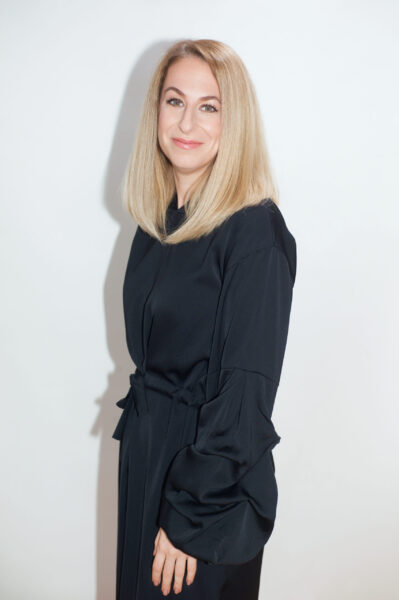
And have you made use of the feedback you received while having read them from one book to write another new one?
No. When I write, I write for myself. It may sound selfish, but I believe that writers, when facing the piece of paper alone, shouldn’t have an audience in mind, neither try to align themselves with the preferences of the market, of the audience, of a certain category. Of course, there is not only black and white, since, when writing for children, you must take into consideration the age group you’re addressing to. There is a big difference between writing for 3- to 5-year-olds and writing for teenagers, you have to adapt your language, speech and type of story. Their feedback inspires me the same way I am inspired by everything that happens around me. If a child tells me something funny, or if I see a leaf falling in a particular way, or if a certain light or reply persists in my memory, all these things melt into a pot; but no way am I dictating a character to do something only because I know it will attract the kids, unless it is something that comes naturally to me. On the other hand, for years I had a representative sample at home: having two kids, many of my books were read and almost created with them, since they were taking part in the process. Now they got older and don’t think it’s cool anymore, but they were my little “test” cell.
What does it mean to be successful as a writer of literature for children in Romania?
It depends on how we define this success, whether we refer to commercial success or to something else. I don’t think we can talk about such thing as real commercial success in Romania – we don’t have any great numbers to speak of, or sales of hundreds of thousands of copies, or remarkable awards that matter. For me, the messages I receive from children are the most important thing.
Do they have the courage to write?
They do, I receive messages on Facebook from kids who very beautifully and movingly tell me how my stories touched them in a way or another. Or they just ask me questions. For me, this is a wonderful thing that our generation couldn’t have dreamt of: to have the possibility to get in touch with a writer after having read their book, to speak your mind and openly ask them a question as well. The messages from kids and their genuine reactions at readings or workshops bring me a lot of joy; apart from these things, I don’t know, I think that a writer’s joy is highly self-centred, when succeeding in finishing a story. Although you feel very nostalgic at that moment… and somehow liberated as well, because you know that you succeeded to put in a story a piece of your mind and of the world you lived in maybe for years and years, and you’re happy with the result. Only you. You feel that you did everything you could, that it turned out right and that you’re happy with it, and at that moment you don’t worry about what will happen with it. Of course, after the book is released, since we’re all human, a negative opinion can upset us, but for me that is the moment to savour, after having a hard time writing a book and finally finishing it, knowing that it ended at the right time and in the right way.
Now I’m thinking about Miss Day-After-Tomorrow’s trilogy. There’s a universe that you created from scratch, along with the map and all the worlds. How long did it take you to write it?
I’m still in the creation phase. The first book, which is addressed to younger children, Domnișoara Poimâine și joaca de-a timpul, is not part of the trilogy, but it’s the starting point. I wrote it when my daughter was four years old. This means 12 years ago. It was published a bit later, because in the first years we didn’t really find a publisher for it. I’ve been working on this trilogy since 2015, so for about 6 years; it goes on with the characters’ adventures. Right now I’m writing the third volume. Which is somehow consuming, because the story keeps expanding. I’m still very fond of this character, Miss Day-After-Tomorrow, and of the world that I had started to vaguely sketch in the book for children. They stayed with me in my memory and somewhere in a part of my soul, and I kept coming back to all these things until, at some point, I started to write something, to write a sequel. I didn’t think “let’s write a trilogy”, I simply saw the character in another situation, and then, slowly but surely, the story started to take shape. I realized it will fill up some more volumes, and now I ponder whether 3 will be enough. But, since I’ve already announced that it’s going to be a trilogy, maybe the last volume will turn out to be considerably bigger J.
How did you reach the target audience with the workshops for children you organize?
I get suggestions. On one hand, there are events organized by the publishing house, on the other hand, there are institutions that host such events, like the Museum of Romanian Literature, for example, or various bookshops or book clubs, like Fanbook or MiniFanbook, where I’ve been multiple times and met absolutely amazing kids. Or else, elementary school teachers and Romanian teachers write to me – there’s a lot of them. I am glad that there are such initiatives. Pretty recently I had a workshop with the children from a school in Bucharest, their teacher reached me because they really enjoyed one of my books, , Aiurea-n tramvai [Anton’s Adventures in the Land of Pointless Words]. The kids handcrafted a mini-book with a reinterpreted version of the expressions from my book and sent it to me as a gift. It was so heart-warming! So, there are a lot of such projects coming my way. There are also the events at De Basm, where we identify places where we can organize workshops, because we generally aim to reach disadvantaged areas. We have several partners, such as country libraries or local libraries, partners who find connections for us and offer us the opportunity to reach schools, libraries, or other communities.
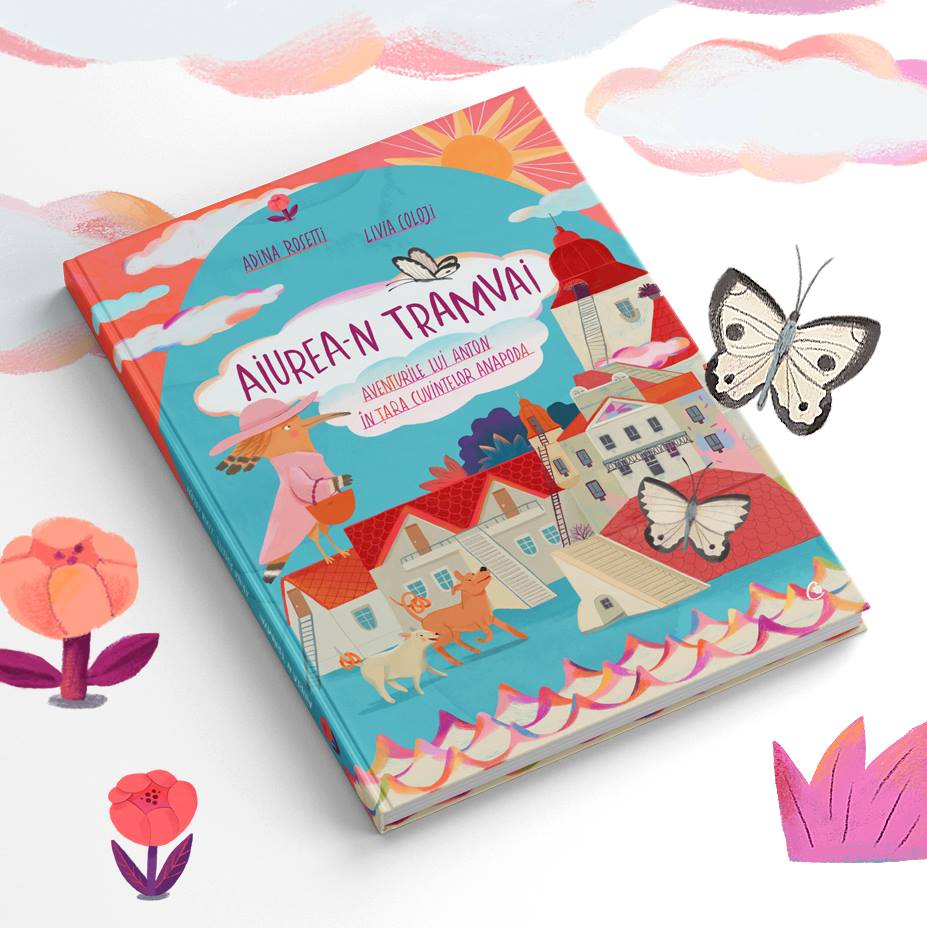
I thought that you had a certain location where you organize the workshops.
I also teach modules of creative writing, but I don’t have a place of my own. The last ones were organized by Odiseea Association, for example, and were held exclusively online.
So this really becomes the norm.
Yes. What is unfortunately missing, and I say this with every occasion, is a governmental initiative. There are no programmes that promote reading, and here we’re not talking about those couple of videos that the ministry occasionally posts on Facebook. We’re talking about coherent and dedicated programmes, about a national programme meant to encourage pupils to read, and to bring writers in schools to talk with the children. There are a lot of things that can be done, but the truth is that nothing’s really happening. There are entire areas in this country where children do not have access to books, where not even the nearest town has a bookshop. For me, a network seems to be missing. And without the support of a state institution and of a, ultimately, political vision, all that is happening is just like small drops. Everybody minds their own business.
From your experience so far, which topics are best received by children: the fantastic or the realistic ones, those to which they can easily relate?
It somehow depends a lot on their age. If you ask them, they firstly respond that they like the fantastic more. Because there are many Fantasy series in fashion, due to the advertising of a genre that is well received, especially abroad, in England and USA. And, since the children are well-accustomed with these series, they will say that they like the fantastic. In fact, there are a lot of books that children love, which are, let’s say, written in a realistic manner, and which present the stories and problems of children their age. I have an example in mind, although it’s not one of my favourites: that series with the diaries of a wimpy kid. They enjoy these books because they’re funny and somehow relatable for them. But I think that only up to a point, because they lack individuality. Look, Alex Moldovan’s book, for instance: children really love Olguța and I believe that many of them can relate to this character and to the atmosphere there, which is more familiar than the adventures of some kids from New York. My children have all kinds of phases, their preferences also differ. For example, my son is crazy about historical subjects and there is a series from Arthur, very on point, of novels for children inspired by various historical events, from the Holocaust to Chinese communism. Coming back to your question, I don’t necessarily believe in literary topics, but rather in how they are tackled. It’s very easy to classify literature, to break it down into topics and genres. But its hidden part, which ultimately catches your imagination without realizing it and which you can’t really put your finger on, especially as a child, is the way in which a story is written, in which the author presents their topic, manages to make themselves trusted and creates a whole new world. And then it doesn’t matter anymore whether it’s realistic, fantastic or sci-fi. A good and well-written book, regardless of its genre and topic, will always catch your imagination and one way or another make you feel emotional.
As Alex Moldovan who you mentioned earlier says, maybe many authors write for parents and not for children.
This is how I personally explain the success some titles have. Until a certain age, the parents are the ones who decide what books to buy, especially when the children are very young, under 10. And, since the parents are overwhelmed by problems, they want a quick solution, a book – they don’t necessarily have to read literature to their kids – that will solve one of those problems. How to use the potty, how to not be afraid of monsters, how to act politely… Don’t get me wrong, I’m not against this type of books, they’re helpful in their own way. It’s just that I stay away from too obvious morals. As a child, I didn’t like to feel that the author kept insisting on something and that they made up a story only to pass that message on to me, narrated with superiority and with their index finger raised. I believe in a good, true and credible story. With the help of their parents, a child can decipher some things and learn something from this kind of stories, without the need to write that in bold like in a self-help book. This in the easier way. But it seems to me that getting to read a text and try to understand what lies behind still develops some abilities. Even though it requires some more effort and, perhaps, more patience from the parent, to sit there and discover the story along with the child.
You have participated in many festivals or book fairs abroad. How did you get to take part in them? Is there a protocol by which a Romanian writer can be present at such events or is it a personal effort?
I was invited, I don't think there is a way to get there, unless you can go alone, "as an individual". At Bologna Children’s Book Fair I was firstly invited by the Ministry of Culture, I had a few readings with Domnișoara Poimâine. The first contact I had with a fair like this one was absolutely overwhelming, because I realized that children’s books have a truly big industry in Europe and in other countries. There you get to see what experiments take place in this domain, with a wide range of illustration types, with very brave publishing houses, that bring forward very tough and difficult subjects, such as, I don’t know, death, God, migration, famine. At first, you would say that a child doesn’t want something like this. “Do you want mommy to read you a story about death and migration?” “Nooo, I want Harry Potter,” the child responds. Apart from the really big publishing houses, which are also split into categories and imprints, there are small publishing houses as well, with specific niches on certain types of illustrations or on highly controversial subjects. It’s a necessary experience, if you want to publish books for children, you must go to Bologna at least once, because it broadens your horizons a lot. The second time, I went to Bologna with my colleagues from De Basm, as in a trip, on our own. You can accredit yourself as a writer, journalist, or editor and simply visit the fair, which is not intended for the general public, but for the professionals in the industry.
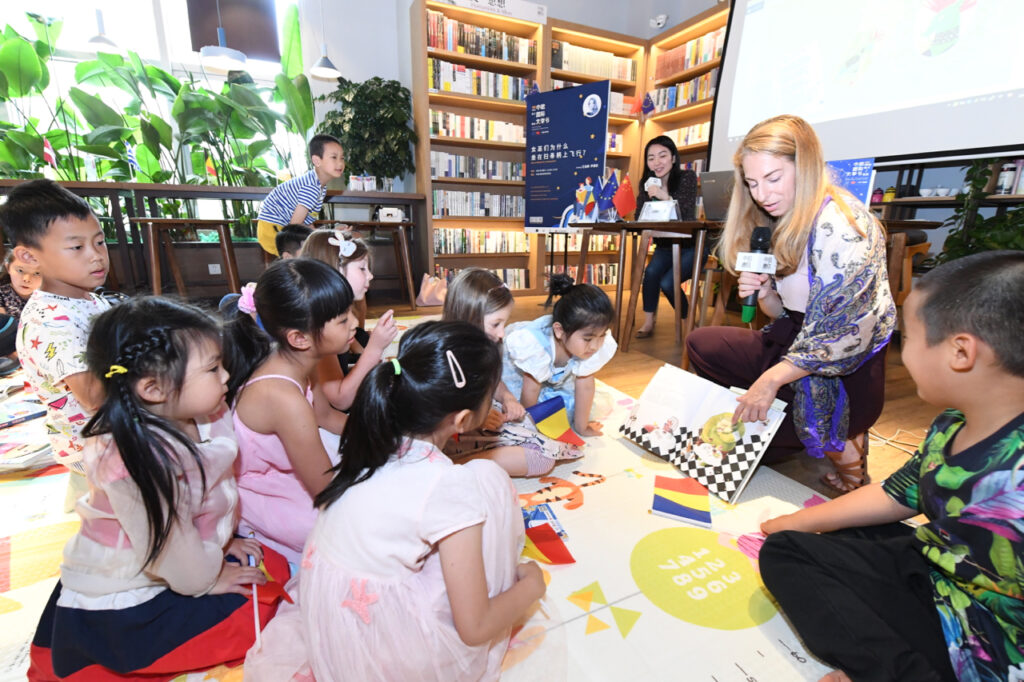
I saw you were in China too.
Yes, at the EU-China International Literary Festival, I was invited through those who administer our country’s participation in book fairs. There are two entities – the Ministry of Culture and the Romanian Cultural Institute – that select the participating authors.
And how do you get to be selected?
You need to have visibility, I assume that they monitor what is going on and choose based on some criteria only they know. I was lucky enough to go to a lot of these fairs – in Beijing, in Madrid, in Leipzig, in Istanbul. I don’t know how we were selected, I did nothing apart from writing, that’s what a writer should do.
Were you inspired by these experiences in your personal projects or in those of De Basm’s?
De Basm started, first of all, from our need, as writers, to be together, to have a common voice. Then from what I observed it was missing, by interacting with children and having some experiences and personal projects in this domain, along with each of the four founders. Romanian literature is either placed high above, on a pedestal out of reach, or it’s regarded as a Cinderella of arts, and children’s literature is briefly categorized as a ‘secondary genre’ – it’s the first that gets cancelled out from the list of literary awards and so on. We also started De Basm out of our wish to change this. Yes, our participation in literary festivals abroad counted indeed, there we got to know other cultures and saw how many things could be done. I believe that this is what inspired us when we created LittleLIT – the children’s literature festival we first organized in 2019.
One of De Basm’s aims is to represent its members in relation with various institutions, including publishing houses. How does this representation actually take shape and what effects has it had so far? And what does the representation in relation with state institutions consist of and how does it work?
We are neither literary agents, nor managers, we don’t represent an author in their personal relation with any publishers or institutions. We are, rather, cultural mediators, trying to bring together everybody from the children’s books industry through our projects: writers, illustrators, teachers, librarians, and other institutions that could help to promote children’s literature. So far we have worked on projects funded mainly by A.F.C.N., projects through which we try to include as many De Basm members as possible (currently there are 20 writers in the association). Then, we intend to set some standards meant to normalize somehow this profession of being a writer, because yes, it is a job! The belief that writers should do everything exclusively out of passion floats in the air, but if you can’t make a living out of what you write (and out of related projects), you’ll have to get a 9 to 5 job, and then you’re left with no more time for writing. This is why we’re campaigning, informally for now, for the writer’s rights J . And those who join the association can propose and develop projects to promote reading, with our help.
There are several associations of writers and artists in Romania. What made you create one exclusively for writers and illustrators of children’s books? Isn’t there a risk of wasting the collective effort if there are many such associations?
I think there’s enough room for everyone! Besides, from what I know, an organisation strictly addressing children’s literature doesn’t exist in Romania. And De Basm also collaborates well with many other artists’ associations or NGO’s in the social domain, in various projects – I would mention a few partners such as Replika, Împreună Agency, EduCab network.
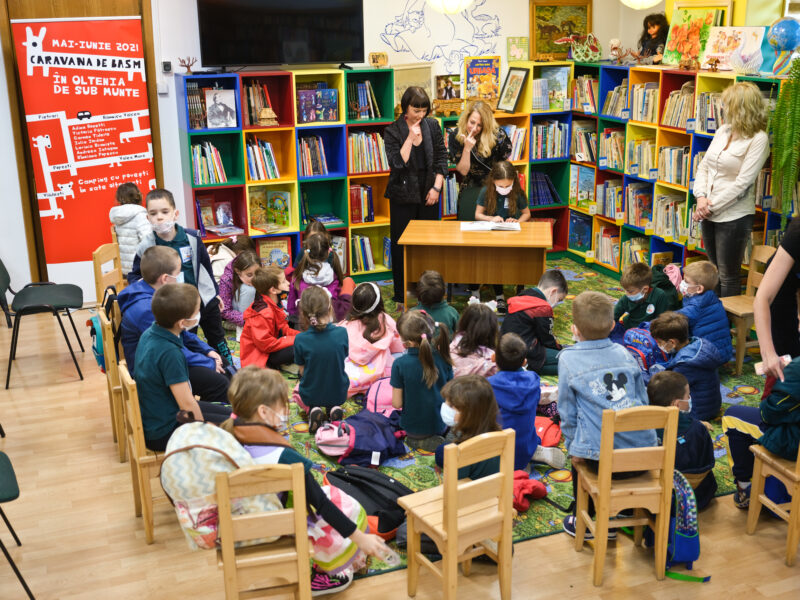
LittleLIT and Nesupusele Caravan Nesupusele [The Untamed / 100 women for 100 years of modern Romania] are some of the most extensive and visible projects of the De Basm association. How did you manage to reach your target audience, both children and parents, and what do you think that convinced them to participate in your events?
Our first #debasm project was Nesupusele, which enjoyed great enthusiasm from the audience, exceeding our expectations. The Caravans followed – we first went with Nesupusele through the country (I think that we reached over 40 villages in rural areas), last year (how we could, since it was a pandemic year) we managed to reach only two villages, and this year we’ve just ended a Caravan in Vâlcea County; these “caravans” mean series of reading and creative writing workshops for children, held by De Basm authors in rural areas – our focus specifically lies on these culturally disadvantaged areas. We try to reach as many places like these as possible, there is a great need that is impossible to fulfil only with a few people and a limited budget. As I said in the previous answer, we have reliable partners with whom we go in schools, libraries, bookshops, where we work with groups of children.
LittleLIT was also created from the desire to bring the audience closer to the authors, but also the writers among themselves, this is why, in addition to the authors’ visits in schools and the events with large public, we have designed a series of workshops held by foreign guests – we’ve had writers from 5 European countries, who came with the support of cultural institutes – for the professionals of written Romanian culture. It was a first edition that we have worked a lot on, and that maybe wasn’t as visible as we’d wanted, and then an empty year followed, but we’re going to return this October with Zilele LittleLIT – Împreună.
Is the book market in Romania a fairy tale world?
Anything can be a fairy tale world, which doesn’t mean that it’s a realm of the fairies, since a fairy tale also has some negative characters and a lot of trials the hero has to go through. I would say that it’s a good thing it exists, looking on the bright side of things. There’s a fantastic evolution compared to 10 years ago or, going back even further in time, compared to the ‘90s, when everything that meant Romanian children’s literature suddenly collapsed – such as Ion Creangă Publishing House. We had a great school of illustrations in the 70s and 80s, that left us with some books like jewellery; there were huge circulations because everything was subsidized by the state, centralized, and the books went everywhere. After the Revolution, we entered a black hole with regard to children’s literature, packs of books that weren’t necessarily valuable started entering the country, having very poor aesthetics, Disney translations, well-known things, with some hastily sketched illustrations; children’s books were not seen as beautiful objects, but as consumer goods. Very few authors got to publish something until after 2000. A publishing house didn’t even look at you, on the pretext that Romanian authors “didn’t sell”. This belief lasted for a long time, because we were eager to consume products from abroad, thinking that those were better than ours. And I think that this also demotivated the writers to start writing children’s literature. Now it’s obvious that things have started to work out. First of all, we have this book market, this industry, there are more and more writers. For instance, I’ve noticed that many of the known writers for adults have published at least one book for children in the past few years: from Dan Coman, to Lucian Dan Teodorovici, T.O. Bobe, and many others. And there are writers who write exclusively for children, like Victoria Pătrașcu, whom I admire a lot and who has been really prolific lately and is loved by the children. It’s the same case with Iulia Iordan, Laura Grunberg, Adina Popescu – there are many writers and illustrators as well. I think that they somehow got ahead.
What do you mean?
At least with respect to their professional way of organization – Illustrators’ Club appeared in 2006. They also contributed to the development of children’s books market, as they released two anthologies of Bookătăria de texte și imagini (coordinated by Florin Bican and Stela Lie), where they put together illustrators and writers, not necessarily for children, but who specifically wrote a text for these anthologies. It was an attempt meant to show that it’s possible and I think they succeeded. At the last physical book fairs it seemed to me that there are more and more stands with books for children. All major publishers which weren’t necessarily regarded as publishers for children now have their own separate collections. Specialized publishing houses have appeared, small ones, but which choose their titles carefully and tackle those less commercial domains, such as Frontiera or Signatura publishing houses, for instance, which release some very beautiful books. So, I think that we’re heading the right way, things start to take shape. There’s still a lot to do, especially if we compare ourselves with the countries where this is a tradition and also a big industry, like France, Italy, USA, where there are specialized literary residencies and programmes that promote reading. Or if we compare ourselves with the Nordic countries, where the state buys and distributes books for children in school libraries; if the state buys a part of the circulation, then the publisher can afford to invest and not be so preoccupied with the immediate income, the authors get to be known and the books reach the children. There are a lot of things that can be done, we have not yet reached this level, but I think we should be positive, to look back and see that we’re growing.
What advice would you give to the writers or illustrators interested to publish books for children? Where should they start, what should they do?
I can’t advise illustrators anything, I think it’s better to leave that to someone with the same profession. The question was about publishing, not writing, right?
Yes.
Let’s say that someone has already written a book and doesn’t know what to do next… First of all, they should do some research and get to know the publishers. Pretty much what a literary agent would do. They should figure out where their story would fit considering its topic and age group, to have an idea about who the book addresses. The publishers will want to know the book’s educational value. But maybe it doesn’t have one, this is fine too. There aren’t really any steps that need to be followed, there is no procedure, these things are not that transparent. Basically, you send the story to publishers and pray that somebody will read it, like it, and then give you a response. What helps, although not officially, is a recommendation from a writer who has already published there.
But if the book is bad, there’s nothing to be done, no publishing house will risk it. Personally, I recommended to some editors I worked with some books which reached me and that I really enjoyed. Some of them got published. There are also people who don’t necessarily aim to become writers, they simply wrote something for their child – or for their inner child – and wish to see their book published. I don’t have any advice to give regarding this, but to be confident and perseverant, and I wish them all the luck.
There is also the other way around: to already have visibility, a fan base, and an online page for the book; I stay away from this type of influencing, because I think it’s supersaturated and that not everything that is presented to us under this title is valuable. But this is the world we live in and these are the things that the public enjoy. Maybe if you go to a publishing house and tell them that you already have a social media page with 100K followers, they may be more interested in you. I’ve published my first book for children at Curtea Veche because I had already published Deadline there and it was an open door. Who knows, if I had come there out of nowhere, I wouldn’t have made it. At that time, there weren’t so many doors open.
In what world, fantastic or not, would you run away with Domnișoara Poimâine, your imaginary friend, for two or three hours, if she accepted to leave her story?
Well, I wouldn’t want her to leave her story, I’d like her to take me there, in all those places that I invented. I resemble a bit those kids that start to believe their imaginary friends are actually real and not just the result of their imagination. Therefore, I wouldn’t get Domnișoara Poimâine out of there.
Where in her world would you go?
I’d go on a journey to the Far Future, on a ship of the Time Pirates, I’d go to Temps d’Amour confectionery, in the Present Square, because I myself had a watery mouth when I was writing about all kinds of cakes found there, and I’d definitely go to a concert by The Leprechauns. First of all, I’d check whether they really sing the lyrics I wrote or not.
(This interview was audio recorded and transcribed. Translated into English by Oana Roxana Dicilea.)

